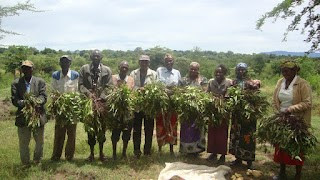Introduction
Sweet potatoes may not be as sweet as the name suggest. Honey is definitely sweeter, however their climate resilience and nutrition qualifies the name. Grown in arid and semi-arid areas, sweet potatoes have proved to be a water efficient cover crop whose ability to withstand different weather condition makes them farmer’s choice. Despite low opinion on them by urban and youthful generation sweet potatoes provide food subsidies to hunger stricken rural communities in arid and semi arid areasMethods of growing sweet potatoes
1. Kitchen
garden
Sweet potatoes can be grown in gunny bags kitchen garden in areas with land and water challenges. In such areas gunny bag is filled with fertile soil to afifth (1/5) fill, then a tin opened on both sides id filled with stones and put at the middle of the gunny bag. Sweet potatoes vines are then planted and the gunny bag folded from outside. The tin is used for irrigation by filling it with water once per week and depending of water requirement due to prevailing climatic conditions. After a period of one month, the vines are held up, soil is refilled and tin pulled upwards, this increases the root structure which is responsible for sweet potatoes developed. The process continues till the gunny bag is full. By the time of the forth refill the first fill has sweet potatoes which can be harvested from the side of the gunny bag. This method provides continual sweet potatoes provision at household level in a vicious circle.
2. Zai pit
garden method
 In zai pit method, a hole
of different dimensions is dug and filled with various materials from the
bottom to top. The bottom is filled with stones and sand while the second level
is filled with dry organic matter. The top column where the sweet potatoes are
to be grown is filled with fertile soil and then sweet potatoes are planted.
Once they have been planted they are irrigated conveniently to form a canopy
which spreads round. The vines are then dug to the ground to increase root
structure and thus sweet potatoes production. This method is appropriate for
very dry areas with minimal rain and every drop needs to be optimized
In zai pit method, a hole
of different dimensions is dug and filled with various materials from the
bottom to top. The bottom is filled with stones and sand while the second level
is filled with dry organic matter. The top column where the sweet potatoes are
to be grown is filled with fertile soil and then sweet potatoes are planted.
Once they have been planted they are irrigated conveniently to form a canopy
which spreads round. The vines are then dug to the ground to increase root
structure and thus sweet potatoes production. This method is appropriate for
very dry areas with minimal rain and every drop needs to be optimized
3. Raised
ridge Method
Advantages of growing sweet potatoes
1. They are
highly adaptive to different weather conditions which reduces crop failure
occurrences
2. They are
resistant to many pests and diseases and are not edible to livestock
3. They are
highly nutritious and convenient for children, the sick and the
elderly
4. Require
minimal labour because activities such as weeding are not a requirement for
their farming
5. Mature
within record of short time and have high demand both in urban and rural areas
hence providing the highly requirement incomes for rural households
6. Through
forming of soil cover canopy, they are able to ensure water efficiency via
reduced evaporation
7. They are
not perishable and can be stored for future consumption
Conclusion
Article by
Andrew M. Nyamu
Project Coordinator-
Coastal Livelihood and Environment Management
Plan International Kenya
www.andrewnyamuonline.blogspot.co.ke









